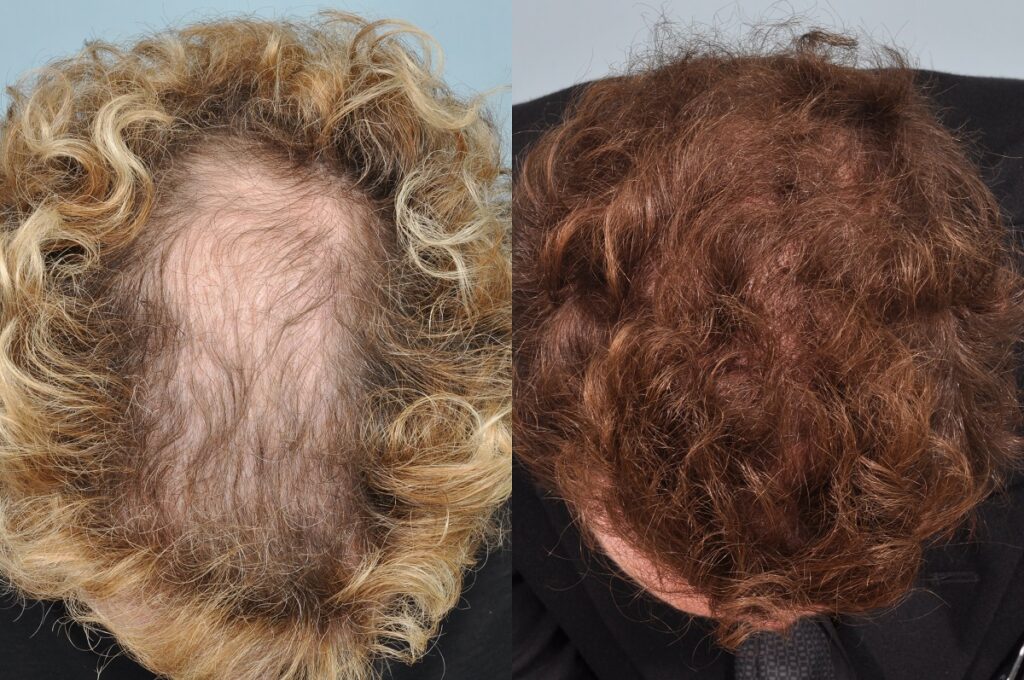The results of your hair transplant is determined by a number of factors which include the skill of the surgeon and team, the design of the transplant, your own ability to heal following surgery, the technique used as well as the number of grafts transplanted. As well as these factors the characteristics of your hair can also have a bearing on the outcome of your hair transplant.
Hair Colour
The colour of your hair can affect the outcome of your hair transplant. A patient with contrasting hair and skin tones will normally notice their hair loss earlier. Whereas a patient with for instance white hair and pale skin will often notice their hair loss at a later stage when the density has reduced further.
Conversely, patients with contrasting hair and skin tones will normally benefit from a greater cosmetic impact following their hair transplant procedure as the transplanted hairs are more noticeable. Often patients following hair transplantation will start to groom their hair more and for some adding a little colour can be beneficial.
Hair Texture
Patients with wavy or curly hair usually notice their hair loss later as the curl in the hair can have the effect of camouflaging the speed at which the hair loss is occurring. When the hair is wavy or curly, the amount of hair that is often lost before the hair loss becomes noticeable is up to 60-70% as opposed to the normal 50%.
These patients can often have excellent outcomes following surgery with the curl giving the appearance of more coverage in the recipient area.
When transplanting very curly hair, the curl can proceed underneath the skin and this makes the possible transection rate of the hair much higher when doing the FUE (follicular unit extraction) procedure. Patients with very curly hair, where it is suspected that the curl can proceed beneath the skin, may be advised to have an FUT (strip) procedure where the individual hair follicles are dissected out, one by one, under a microscope. A patient with very curly hair having an FUE procedure, may have transection rates i.e. damage to the hair roots as high as 20-25% whereas with FUT transplantation, because each hair follicle is individually visualised and prepared by a technician under microscope, the transection rate is normally less than 1–1.5%. This means there is more transplantable hair going into the thinning or balding areas.

A very interesting feature is the development of a wave or curl in the transplanted hair following a hair transplant. Hair that is harvested from the donor region, at the back and sides, may have a curl or wave in it at the time of surgery but all of the grafts are mixed up in the hair transplant procedure. A fascinating feature the team at HRBR have noticed over the years is that when the transplanted hair starts growing to maturity between a year to 18 months, a wave or curl can develop in it. Thus, showing that the characteristics of waviness or curliness appears to be in the recipient area (where the grafts are planted) as well as in the donor area (where the grafts are taken).
Numbers of Hairs per Follicle
The number of hairs per hair follicle also influences the result of a patient’s hair transplant. Most patients will have between 1 and 4 hairs per hair graft. The average in the majority of patients is 2 hairs per graft. For those patients with an average of more than 2 their results following hair transplantation can be above average.
The numbers of hairs per hair graft is reviewed at your preoperative appointment and can vary across the scalp. The team at HRBR keep a careful audit of the number of hairs per hair graft and are careful to place the smaller hair grafts into the hair line with the larger hair grafts, those that provide more density, further back, thus giving a more natural appearance.
Calibre of Hair Shaft
The calibre of the hair shaft can also influence the outcome, with those patients with naturally thicker hair potentially benefiting more cosmetically post hair transplant.
When planning a hair transplant procedure, all of the characteristics of the patient’s hair are taken into account, an individual plan is then prepared that considers the patients current hair loss and characteristics as well as their expected future hair loss.
For more information on hair transplant surgery contact HRBR on 00353 1 209 1000 or info@hrbr.ie









